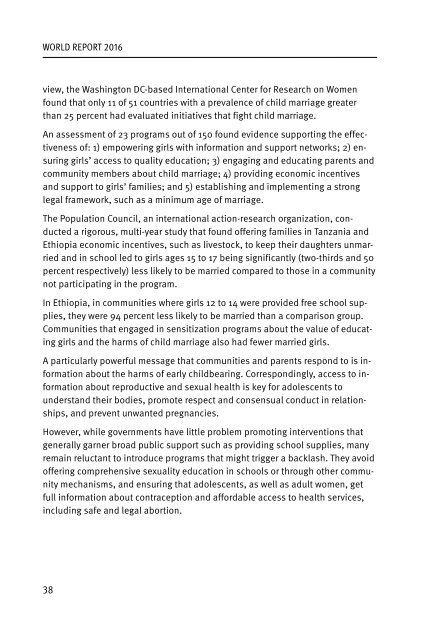You also want an ePaper? Increase the reach of your titles
YUMPU automatically turns print PDFs into web optimized ePapers that Google loves.
WORLD REPORT 2016<br />
HUMAN RIGHTS WATCH<br />
view, the Washington DC-based International Center for Research on Women<br />
found that only 11 of 51 countries with a prevalence of child marriage greater<br />
than 25 percent had evaluated initiatives that fight child marriage.<br />
An assessment of 23 programs out of 150 found evidence supporting the effectiveness<br />
of: 1) empowering girls with information and support networks; 2) ensuring<br />
girls’ access to quality education; 3) engaging and educating parents and<br />
community members about child marriage; 4) providing economic incentives<br />
and support to girls’ families; and 5) establishing and implementing a strong<br />
legal framework, such as a minimum age of marriage.<br />
The Population Council, an international action-research organization, conducted<br />
a rigorous, multi-year study that found offering families in Tanzania and<br />
Ethiopia economic incentives, such as livestock, to keep their daughters unmarried<br />
and in school led to girls ages 15 to 17 being significantly (two-thirds and 50<br />
percent respectively) less likely to be married compared to those in a community<br />
not participating in the program.<br />
In Ethiopia, in communities where girls 12 to 14 were provided free school supplies,<br />
they were 94 percent less likely to be married than a comparison group.<br />
Communities that engaged in sensitization programs about the value of educating<br />
girls and the harms of child marriage also had fewer married girls.<br />
A particularly powerful message that communities and parents respond to is information<br />
about the harms of early childbearing. Correspondingly, access to information<br />
about reproductive and sexual health is key for adolescents to<br />
understand their bodies, promote respect and consensual conduct in relationships,<br />
and prevent unwanted pregnancies.<br />
However, while governments have little problem promoting interventions that<br />
generally garner broad public support such as providing school supplies, many<br />
remain reluctant to introduce programs that might trigger a backlash. They avoid<br />
offering comprehensive sexuality education in schools or through other community<br />
mechanisms, and ensuring that adolescents, as well as adult women, get<br />
full information about contraception and affordable access to health services,<br />
including safe and legal abortion.<br />
The effort to end child marriage cannot succeed without greater acceptance of<br />
adolescent girls’ sexuality and their rights to make their own informed choices<br />
about their bodies, their relationships, and their sexual activity.<br />
Governments and donors can rally around the idea that a 12-year-old girl should<br />
be in school rather than a marriage. Countries such as Canada, the Netherlands,<br />
the United Kingdom, and the United States have been lead donors in combatting<br />
child marriage. But the challenge will be whether they can make sure child marriage<br />
interventions are not standalone efforts disconnected from other undertakings<br />
to empower women and poor communities and promote education and<br />
health.<br />
Governments, whether as donors or as implementers, need to address some<br />
tough questions if they are going to make genuine progress. Do their education<br />
programs include special outreach to married girls? Do national plans of action<br />
on gender-based violence and “women, peace, and security” include<br />
efforts/steps to end child marriage? Do their police training programs on genderbased<br />
violence include policing methods to fight child marriage, such as prosecuting<br />
local officials who sign marriage certificates for underage girls?<br />
Such coordination is crucial to ensuring that critical opportunities are not<br />
missed when allocating resources and programming that will be dedicated<br />
across the expansive<br />
Sustainable Development Goals Agenda<br />
Efforts to end child marriage also mean the donors should press governments to<br />
meet their obligations under international law to eliminate the practice. Key international<br />
human rights treaties include the International Covenant on Civil and<br />
Political Rights, the Convention on the Elimination of All Forms of Discrimination<br />
against Women, and the Convention on the Rights of the Child. While there is<br />
growing evidence of the effectiveness of a number of community-level approaches,<br />
government cooperation, law enforcement, and national-level initiatives<br />
are key to scale and sustainability.<br />
Too often, nongovernmental organizations and donors support innovative programs,<br />
but local government officials undermine their impact by ignoring or even<br />
facilitating child marriage (for example, by changing the age on a birth or mar-<br />
38<br />
39


